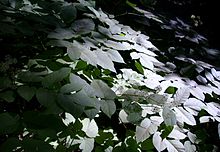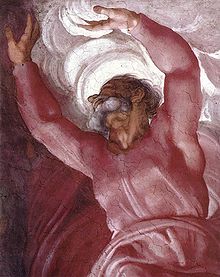- Darkness
-
"Dark" redirects here. For other uses, see Dark (disambiguation).This article is about the absence of light. For other uses, see Darkness (disambiguation).Light shining on a part of a bush. Where light is not reflected, there is darkness.

Darkness, in contrast with brightness, is a relative absence of visible light. It is the appearance of black in a color space. When light is not present, rod and cone cells within the eye are not stimulated. This lack of stimulation means photoreceptor cells are unable to distinguish color frequency and wavelength. The resulting perception is achromatic and in the case of darkness, black. The emotional reaction to darkness has metaphorical importance in many cultures.
Contents
Scientific
A dark object absorbs photons, and therefore appears dim in comparison to other objects. For example, matte black paint does not reflect visible light and appears dark, but white paint reflects all visible light and appears bright.[1] For more information see color.
However, light cannot simply be absorbed without limit. Energy, like visible light, cannot be created or destroyed. It can only be converted from one type of energy to another. Most objects that absorb visible light reemit it as infrared light.[2] So, although an object may appear dark, it is likely bright at a frequency that a human being cannot see. For more information see thermodynamics.
A dark area has limited light sources, making things hard to see. Exposure to alternating light and darkness (night and day) has caused several evolutionary adaptations to darkness. When a vertebrate, like a human, enters a dark area, its iris dilates, allowing more light to enter the eye and improving night vision. Also, the light detecting cells in the human eye (rods and cones) will regenerate more unbleached rhodopsin when adapting to darkness.
One scientific measure of darkness is the Bortle Dark-Sky Scale, which indicates the night sky's and stars' brightness at a particular location, and the observability of celestial objects at that location. (See also: Sky brightness)
Cultural
Further information: Light and darknessPoetic
As a poetic term in the Western world, darkness can also mean the presence of shadows, evil, or depression. Religious texts often use darkness to make a visual point. In the Bible, darkness was the second to last plague (Exodus 10:21) and the location of “weeping and gnashing of teeth.” (Matthew 8:12)[3] The Qur’an has been interpreted to say that those who transgress the bounds of what is right are doomed to “burning despair and ice-cold darkness.” (Nab 78.25)[4]
In Chinese philosophy Yin is the feminine part of the Taijitu and is represented by a dark lobe.
The use of darkness as a rhetorical device has a long standing tradition. Shakespeare, working in the 16th and 17th centuries, made a character called Satan, the “prince of darkness” (King Lear: III, iv) and gave darkness jaws with which to devour love. (A Midsummer Night’s Dream: I, i)[5] Chaucer, a 14th century Middle English writer, wrote that knights must cast away the “workes of darkness.”[6] Dante described hell as “solid darkness stain’d.”[7]
In Old English there were three words that could mean darkness: heolstor, genip, and sceadu.[8] Heolstor also meant “hiding-place” and became holster. Genip meant “mist” and fell out of use like many strong verbs. It is however still used in the Dutch saying "in het geniep" which means secretly. Sceadu meant “shadow” and remained in use. The word dark eventually evolved from the word deorc.[9]
Artistic
Artistically, darkness can also be used to emphasize or contrast with light. See chiaroscuro for a discussion of the uses of such contrasts in visual media.
Color paints are mixed together to create darkness, because each color absorbs certain frequencies of light. Theoretically, mixing together the three primary colors, or the three secondary colors, will absorb all visible light and create black. In practice it is difficult to prevent the mixture from taking on a brown tint.
The color of a point, on a standard 24-bit computer display, is defined by three numbers between 0 and 255, one each for red, green, and blue. Because the absence of light creates darkness, darker colors are closer to (0,0,0).
Paintings may use darkness to create leading lines and voids, among other things. These shapes are designed to draw the eye around the painting. Shadows add perspective.
See also
- Lightness (color)
- Dark tourism - travel to sites associated with death and suffering
- Shadow
References
- ^ Mantese, Lucymarie (March 2000). Photon-Driven Localization: How Materials Really Absorb Light. American Physical Society. http://adsabs.harvard.edu/abs/2000APS..MAR.E2001M. Retrieved 2007-01-21.
- ^ Dr. Denise Smith (powerpoint). Exploring the Electromagnetic Spectrum: The Herschel Experiment. Space Telescope Science Institute. Archived from the original on 2007-02-06. http://web.archive.org/web/20070206175002/http://www.tufts.edu/as/wright_center/work_con_lec/astro_wkshp_res/boston_herschel.ppt. Retrieved 2007-01-21.
- ^ BibleGateway.com
- ^ "Online translation of The Quran". http://www.islamicity.com/quransearch/. Retrieved November 2010.
- ^ Shakespeare, William. "The Complete Works". The Tech, MIT. http://shakespeare.mit.edu/.
- ^ Chaucer, Geoffrey (14th century). The Canterbury Tales, and Other Poems. The Second Nun’s Tale. http://www.gutenberg.org/etext/2383.
- ^ Alighieri, Dante; Translated by: Henry Francis (14th century). The Divine Comedy. http://www.gutenberg.org/etext/8800.
- ^ Mitchell, Bruce; Fred C. Robinson (2001). A Guide to Old English. Glossary: Blackwell Publishing. pp. 332, 349, 363, 369. ISBN 0-631-22636-2.
- ^ Harper, Douglass (November 2001). "Dark". Online Etymology Dictionary. http://www.etymonline.com. Retrieved 2007-01-18.
Categories:- Darkness
- Symbols
Wikimedia Foundation. 2010.



